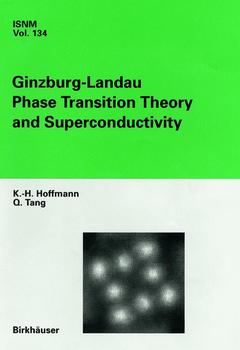Ginzburg-Landau Phase Transition Theory and Superconductivity, 2001 International Series of Numerical Mathematics Series, Vol. 134
Langue : Anglais
Auteurs : Hoffmann K.-H., Tang Q.

The theory of complex Ginzburg-Landau type phase transition and its applica tions to superconductivity and superfluidity has been a topic of great interest to theoretical physicists and has been continuously and persistently studied since the 1950s. Today, there is an abundance of mathematical results spread over numer ous scientific journals. However, before 1992, most of the studies concentrated on formal asymptotics or linear analysis. Only isolated results by Berger, Jaffe and Taubes and some of their colleagues touched the nonlinear aspects in great detail. In 1991, a physics seminar given by Ed Copeland at Sussex University inspired Q. Tang, the co-author of this monograph, to study the subject. Independently in Munich, K.-H. Hoffmann and his collaborators Z. Chen and J. Liang started to work on the topic at the same time. Soon it became clear that at that time, groups of mathematicians at Oxford and Virginia Tech had already studied the subject for a couple of years. They inspired experts in interface phase transition problems and their combined effort established a rigorous mathematical framework for the Ginzburg-Landau system. At the beginning Q. Tang collaborated with C.M. Elliott and H. Matano.
1 Introduction.- 1.1 Brief history.- 1.2 The G-L phenomenological theory.- 1.3 Some considerations arising from scaling.- 1.4 The evolutionary G-L system – 2-d case.- 1.5 Exterior evolutionary Maxwell system.- 1.6 Exterior steady-state Maxwell system.- 1.7 Surface energy, superconductor classification.- 1.8 Difference between 2-d and 3-d models.- 1.9 Bibliographical remarks.- 2 Mathematical Foundation.- 2.1 Co-dimension one phase transition problems.- 2.2 Co-dimension two phase transition problems.- 2.3 Mathematical description of vortices in ?2.- 2.4 Asymptotic methods for describing vortices in ?2.- 2.5 Asymptotic methods for describing vortices in ?3.- 2.6 Bibliographical remarks.- 3 Asymptotics Involving Magnetic Potential.- 3.1 Basic facts concerning fluid vortices.- 3.2 Asymptotic analysis.- 3.3 Asymptotic analysis of densely packed vortices.- 3.4 Bibliographical remarks.- 4 Steady State Solutions.- 4.1 Existence of steady state solutions.- 4.2 Stability and mapping properties of solutions.- 4.3 Co-dimension two vortex domain.- 4.4 Breakdown of superconductivity.- 4.5 A linearized problem.- 4.6 Bibliographical remarks.- 5 Evolutionary Solutions.- 5.1 2-d solutions with given external field.- 5.2 Existence of 3-d evolutionary solutions.- 5.3 The existence of an ?-limit set as t ? ?.- 5.4 An abstract theorem on global attractors.- 5.5 Global atractor for the G-L sstem.- 5.6 Physical bounds on the global attractor.- 5.7 The uniqueness of the long time limit of the evolutionary G-L so-lutions.- 5.8 Bibliographical remarks.- 6 Complex G-L Type Phase Transition Theory.- 6.1 Existence and basic properties of solutions.- 6.2 BBH type upper bound for energy of minimizers.- 6.3 Global estimates.- 6.4 Local estimates.- 6.5 The behaviour of solutions nearvortices.- 6.6 Global ?-independent estimates.- 6.7 Convergence of the solutions as ? ? 0.- 6.8 Main results on the limit functions.- 6.9 Renormalized energies.- 6.10 Bibliographical remarks.- 7 The Slow Motion of Vortices.- 7.1 Introduction.- 7.2 Preliminaries.- 7.3 Estimates from below for the mobilities.- 7.4 Estimates from above for the mobilities.- 7.5 Bibliographical remarks.- 8 Thin Plate/Film G-L Models.- 8.1 The outside Maxwell system – steady state case.- 8.2 The outside field is given – evolutionary case.- 8.3 The outside field is given – formal analysis.- 8.4 Bibliographical remarks.- 9 Pinning Theory.- 9.1 Local Pohozaev-type identity.- 9.2 Estimate the energy of minimizers.- 9.3 Local estimates.- 9.4 Global Estimates.- 9.5 Convergence of solutions and the term $$ \frac{1} {{\varepsilon ^2 }}\int_\Omega {(\left| {\psi _\varepsilon } \right|^2 - 1)^2 } $$.- 9.6 Properties of ?*, A*.- 9.7 Renormalized energy.- 9.8 Pinning of vortices in other circumstances.- 9.9 Bibliographical remarks.- 10 Numerical Analysis.- 10.1 Introduction.- 10.2 Discretization.- 10.3 Stability estimates.- 10.4 Error estimates.- 10.5 A numerical example.- 10.6 Discretization using variable step length.- 10.7 A dual problem.- 10.8 A posteriori error analysis.- 10.9 Numerical implementation.- 10.10 Bibliographical remarks.- References.
Date de parution : 10-2012
Ouvrage de 384 p.
15.5x23.5 cm
Disponible chez l'éditeur (délai d'approvisionnement : 15 jours).
Prix indicatif 105,49 €
Ajouter au panierDate de parution : 12-2000
Ouvrage de 384 p.
15.5x23.5 cm
Thème de Ginzburg-Landau Phase Transition Theory and... :
© 2024 LAVOISIER S.A.S.
